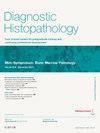测试非小细胞肺癌的基因组生物标志物
引用次数: 0
摘要
近年来,获准用于非小细胞肺癌(NSCLC)的靶向疗法数量大幅增加,导致对组织标本进行基因组检测的需求大增。目前,NSCLC 中可检测的基因改变类型多种多样,这反映了当前检测方法的复杂性。细胞病理学家在对组织标本进行基因组生物标记物检测分流方面起着关键作用,他们应该熟悉 NSCLC 中的基因组改变、所采用的检测策略以及如何解读分子病理报告,以便有效地支持 NSCLC 患者的治疗。本文章由计算机程序翻译,如有差异,请以英文原文为准。
Testing for genomic biomarkers in non-small-cell lung cancer
The number of targeted therapies licenced for non-small cell lung cancer (NSCLC) has increased substantially in recent years, resulting in a major increase in demand for genomic testing of tissue specimens. The range of different alteration types that are now actionable in NSCLC is reflected in the complexity of current testing approaches. Cellular pathologists hold a key role in triaging tissue specimens for genomic biomarker testing and should be familiar with the genomic alterations seen in NSCLC, the testing strategies utilised and how to interpret molecular pathology reports in order to effectively support the management of NSCLC patients.
求助全文
通过发布文献求助,成功后即可免费获取论文全文。
去求助
来源期刊

Diagnostic Histopathology
Medicine-Pathology and Forensic Medicine
CiteScore
1.30
自引率
0.00%
发文量
64
期刊介绍:
This monthly review journal aims to provide the practising diagnostic pathologist and trainee pathologist with up-to-date reviews on histopathology and cytology and related technical advances. Each issue contains invited articles on a variety of topics from experts in the field and includes a mini-symposium exploring one subject in greater depth. Articles consist of system-based, disease-based reviews and advances in technology. They update the readers on day-to-day diagnostic work and keep them informed of important new developments. An additional feature is the short section devoted to hypotheses; these have been refereed. There is also a correspondence section.
 求助内容:
求助内容: 应助结果提醒方式:
应助结果提醒方式:


